These homemade buttermilk biscuits are soft and buttery with hundreds of flaky layers. This biscuit recipe only requires 6 simple ingredients and they’re ready in about 35 minutes.
I originally published this recipe in 2017 and have since added new photos, a video tutorial, and more helpful success tips.
One reader, Marcia, commented: “Finally, a biscuit recipe that worked for me. I especially appreciated the notes which, in fact, had me change some things I had been doing. The detail at all levels, both visual and written, is very helpful. ★★★★★“
Another reader, Maggie, commented: “One of my favorite biscuit recipes! They are so consistently flaky and delicious, every single time! ★★★★★“
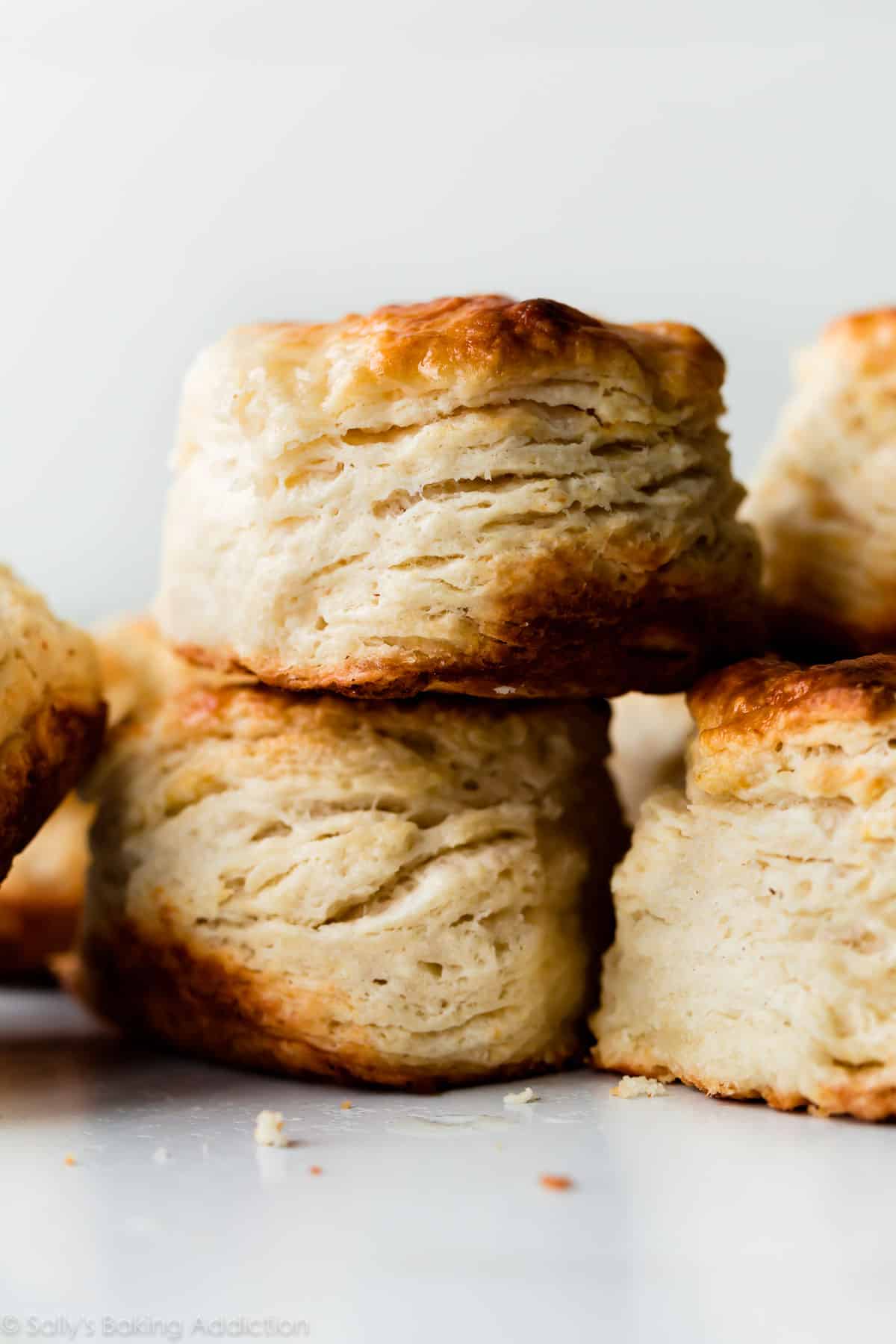
Biscuits. Let’s do it BIG. Big as in mega flaky, mega fluffy, mega layers, mega golden brown, and mega buttery. It’s quite serendipitous that this “side dish” may taste even more remarkable than the main event. No, no… it WILL taste more remarkable. Just look at these buttery layers! Nothing can compete.
What are Biscuits?
The term “biscuits” has different meanings depending where you live in the world. In the U.S., biscuits are similar to a dinner roll, but are denser and flakier because they aren’t (typically) made with yeast. Since there’s usually no yeast involved and the rising agent is either baking soda, baking powder, or both—biscuits are considered a quick bread, like banana bread and no yeast bread. In other parts of the world, “biscuits” are more like cookies or scones.
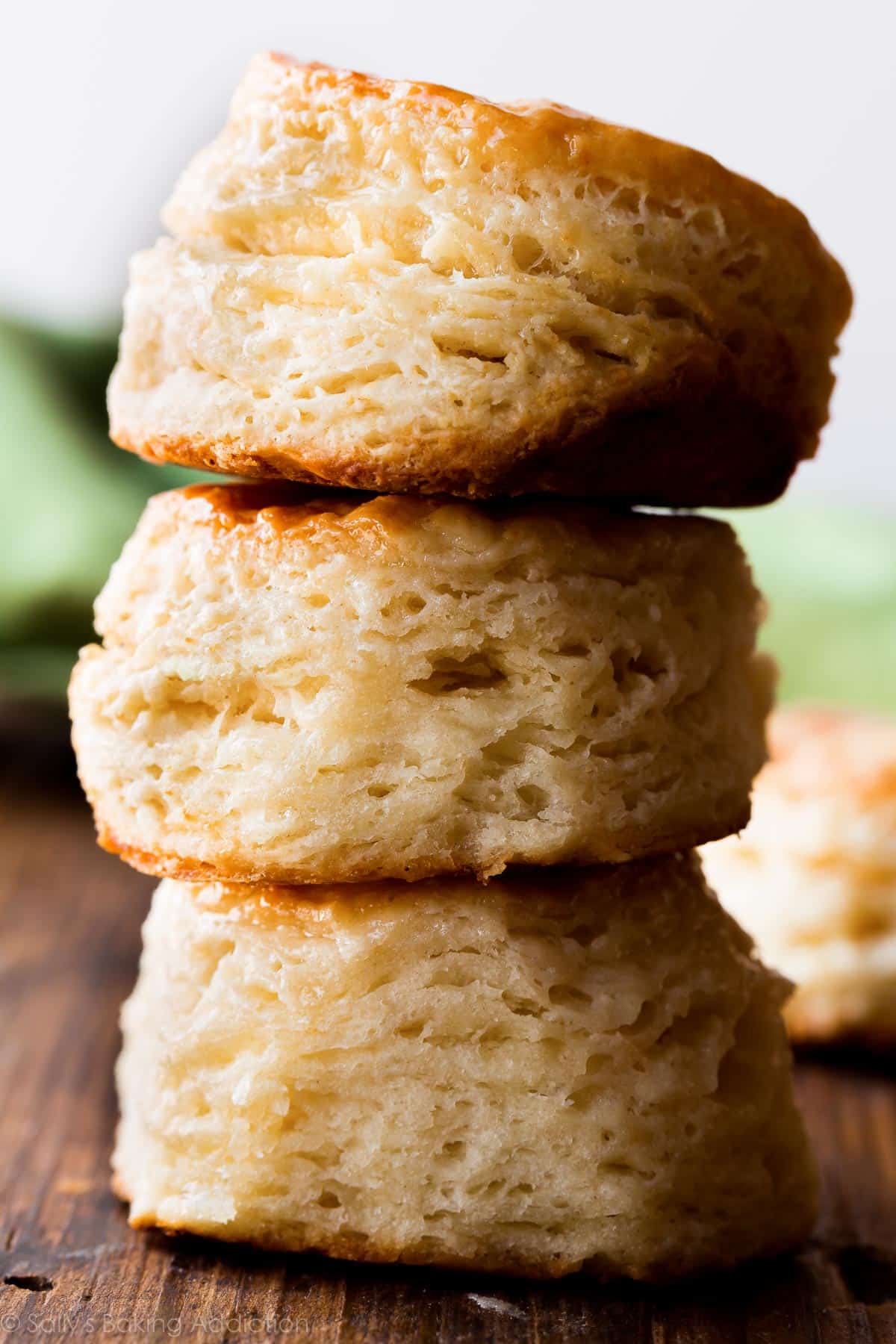
6 Key Ingredients in Buttermilk Biscuits
You need just 6 basic ingredients for my homemade biscuits recipe:
- All-purpose Flour
- Baking Powder
- Salt
- Cold Butter
- Cold Buttermilk
- Honey
With so few ingredients, it’s important to reach for quality ingredients and avoid any substitutions. Notice the emphasis on cold? See tip #1 below.
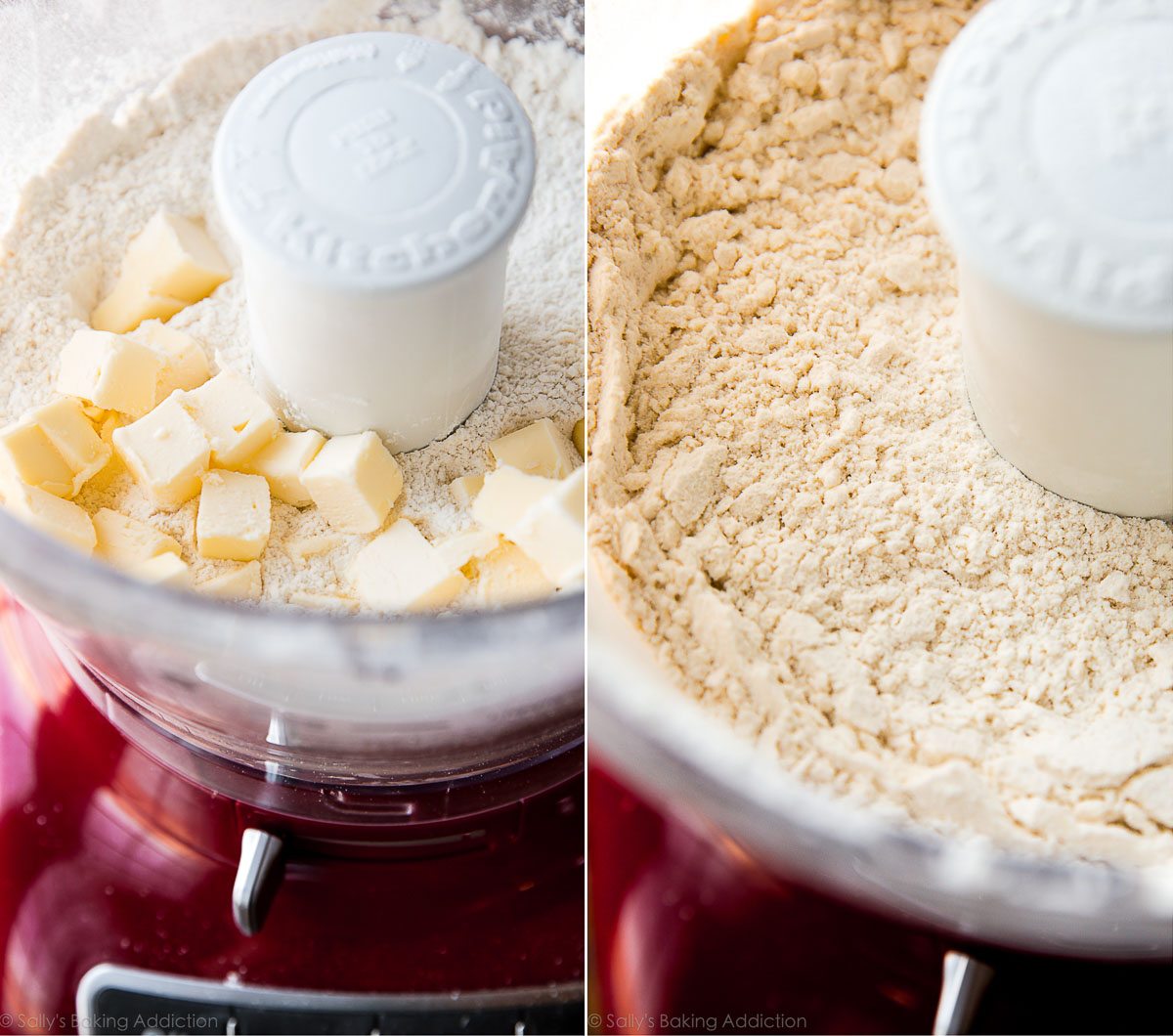
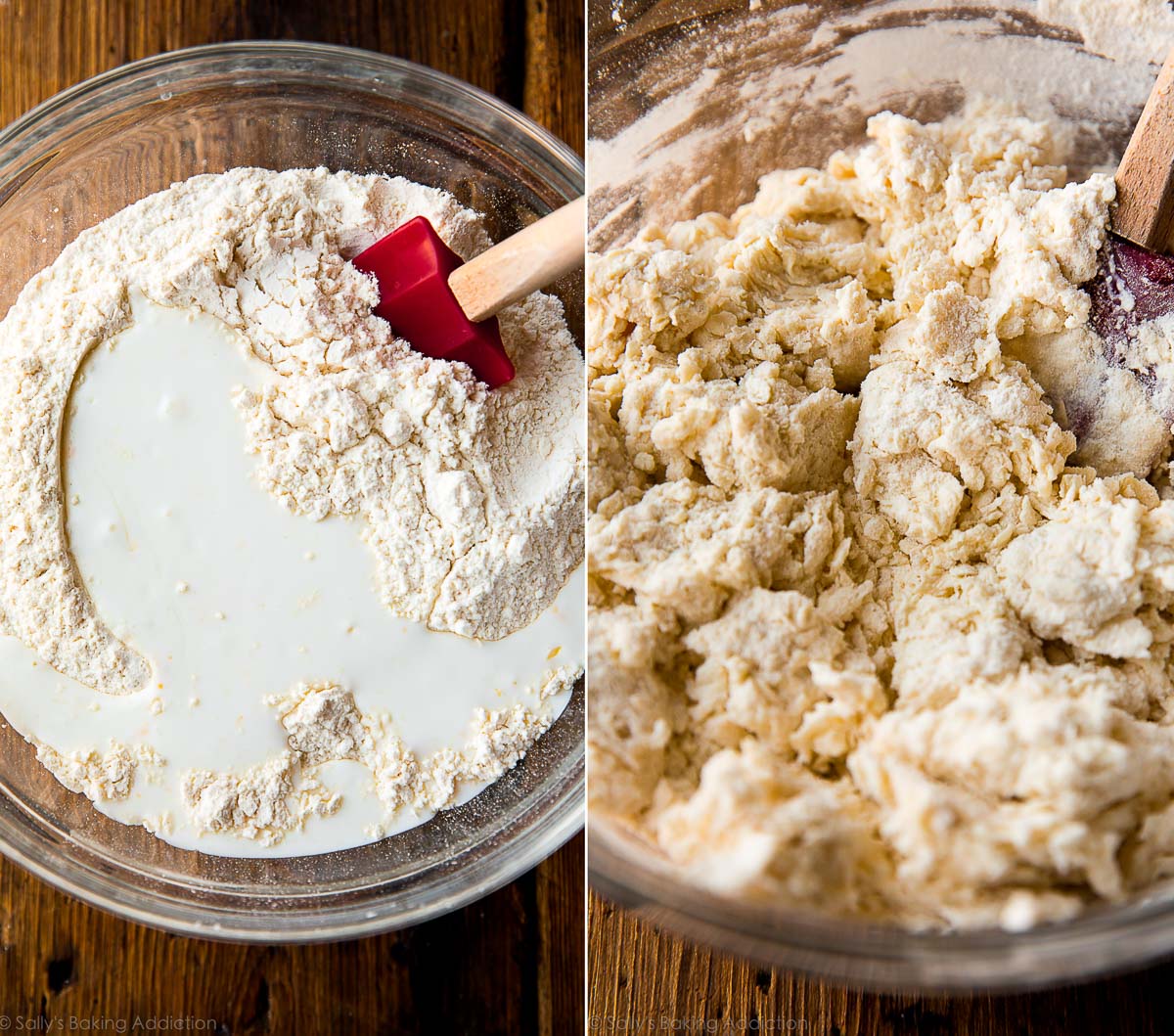
Success Tips for the Best Homemade Biscuits
Let me share what I’ve learned in the world of homemade buttermilk biscuit recipes. I’ve made plenty of mistakes so you don’t have to. These tried-and-true tricks will turn your flat, dry biscuits into the best biscuits ever. And that’s a guarantee.
- Cold Fat: For flaky layers and pockets, use cold butter. When little pieces of butter melt as the biscuits bake, they release steam and create little pockets of air–this makes the biscuits airy and flaky on the inside while remaining crisp on the outside. It’s the same thing that happens when making these ham & cheese scones.
- Buttermilk & Honey for Flavor: Real buttermilk and teeny drizzle of honey balance out the salt. Buttermilk creates the most tender biscuit! If you’re interested, I have plenty more on this topic in my Baking with Buttermilk post (including a DIY buttermilk substitute recipe).
- Don’t Over Mix: Never overwork biscuit dough. Overworking and over-handling biscuit dough will result in tough, hard, and flat biscuits. Mix the ingredients together *just* until combined. Dough will be crumbly; that’s normal.
- Flatten & Fold Method: The most important step of all is folding the dough together. Turn the scrappy dough out onto a work surface and flatten it with your hands. Form into a rectangle. More below.
- Don’t Twist the Biscuit Cutter: When cutting the dough with a biscuit cutter, do not twist the cutter. Press the cutter down into the dough firmly. Twisting it will seal off the biscuit edges, preventing the biscuits from rising.
- Bake Close Together: Biscuits rise up nice and tall when they are touching, pressed snuggly against one another in the oven.
How to Fold Biscuit Dough
Flattening and folding biscuit dough creates multiple flaky layers, just as it does when we make homemade croissants, rough puff pastry, mille-feuille, and croissant bread. This step will take you no more than 2 minutes and you’ll be rewarded with the flakiest biscuits in the world. First, shape dough into a rectangle:
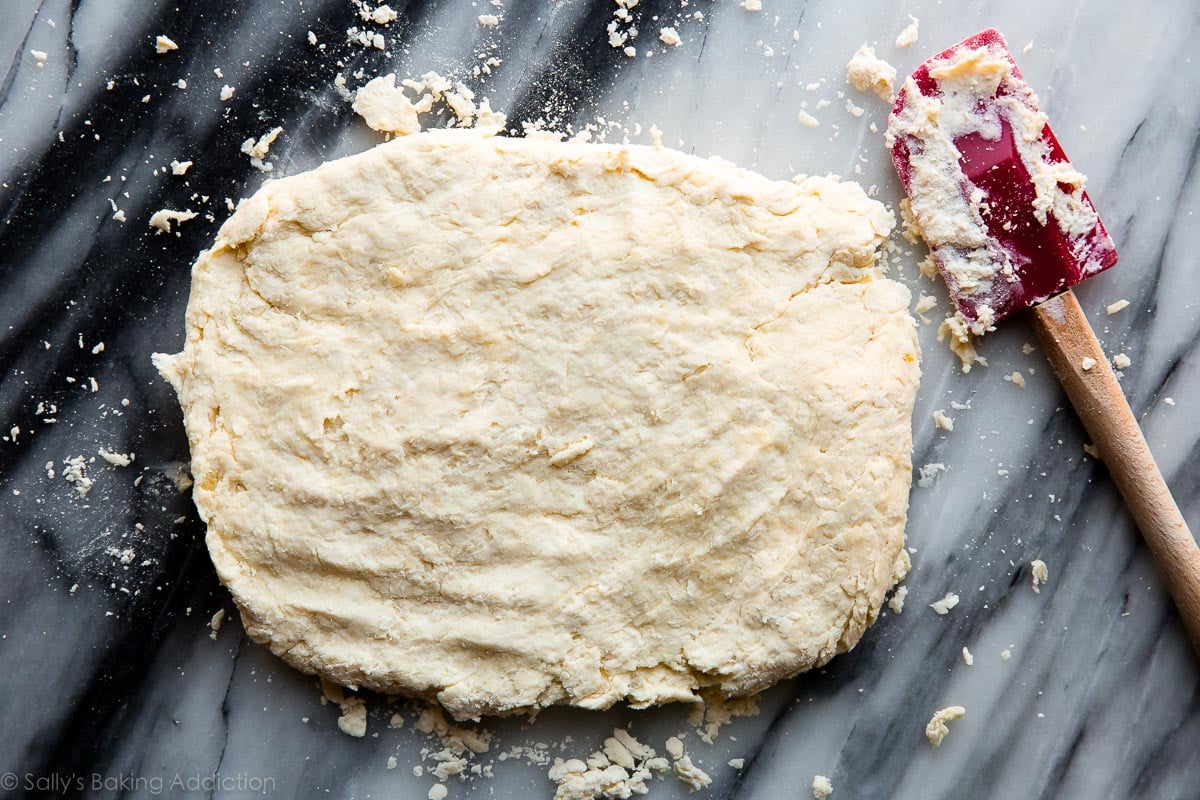
Then fold one side into the center:
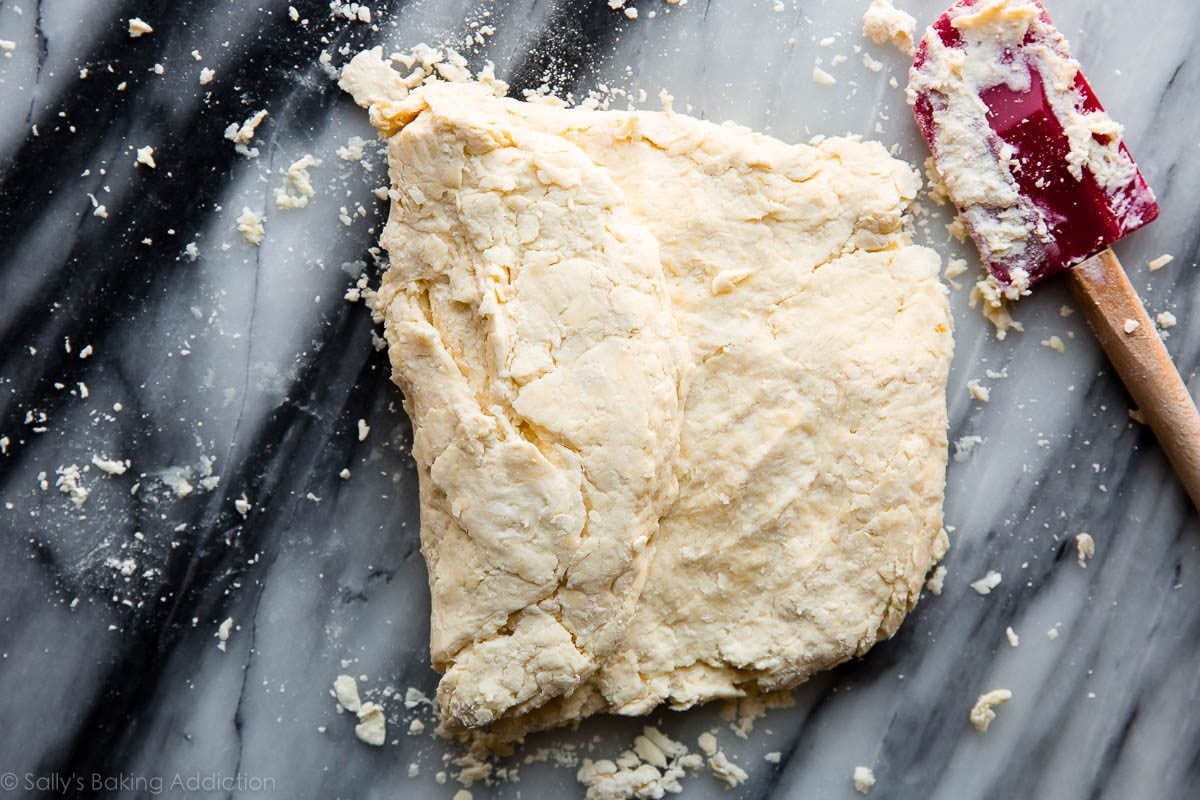
Then the other side:
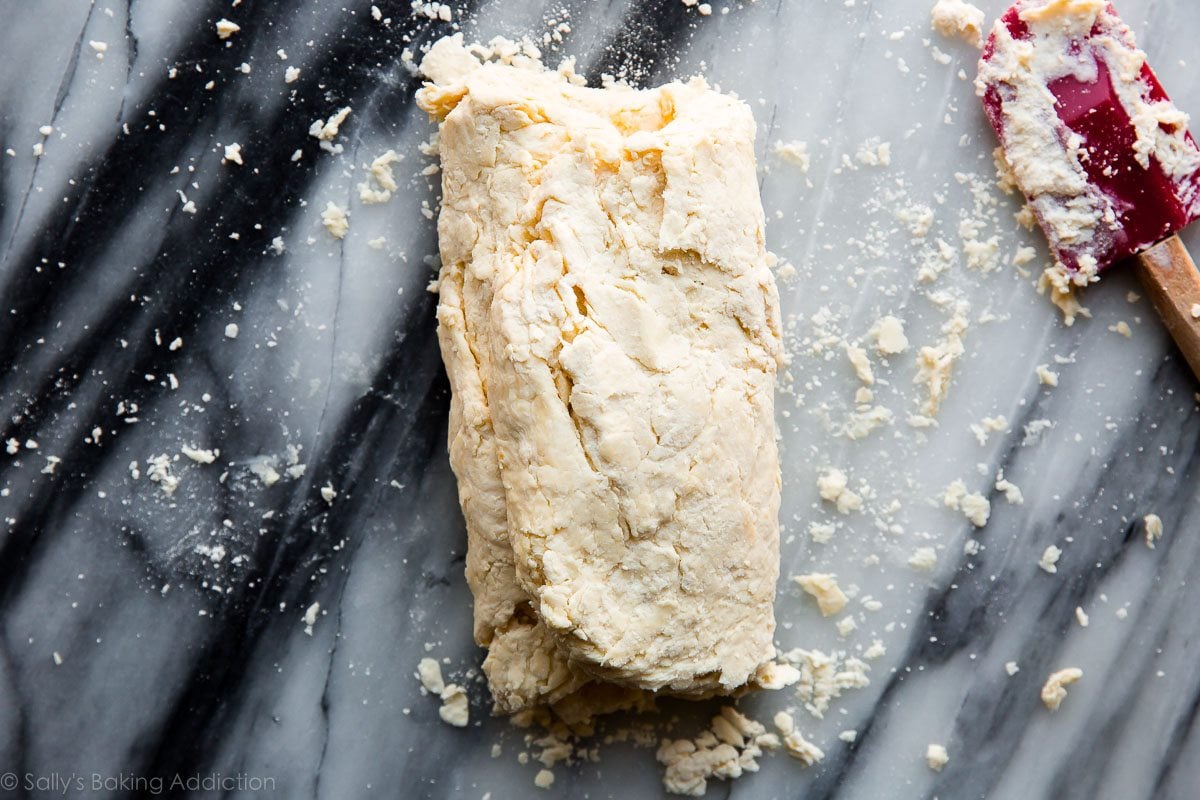
Turn the folded dough horizontal, gently flatten, and begin that folding process 2 more times.
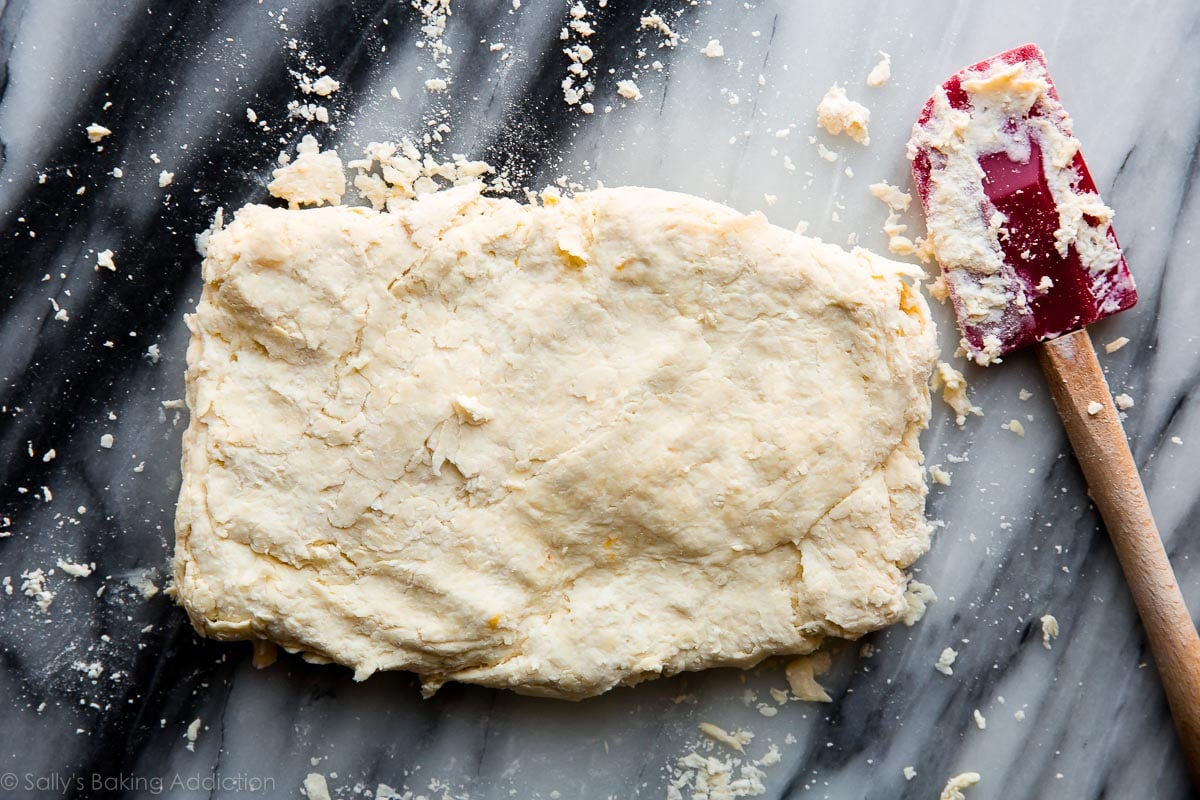
The dough should be about 3/4 inch thick and the biscuits will rise as they bake.
Honey Butter Topping
The honey butter topping is optional, but it will set your biscuits apart from the rest. When the biscuits come out of the oven, brush with a mix of melted butter + honey. You use both ingredients in the biscuit dough, keeping the count at 6 ingredients total.
Serve your homemade biscuits with jam or homemade raspberry sauce, or biscuits and gravy—I love this particular recipe. Or a swipe of homemade honey butter really kicks it up a notch!
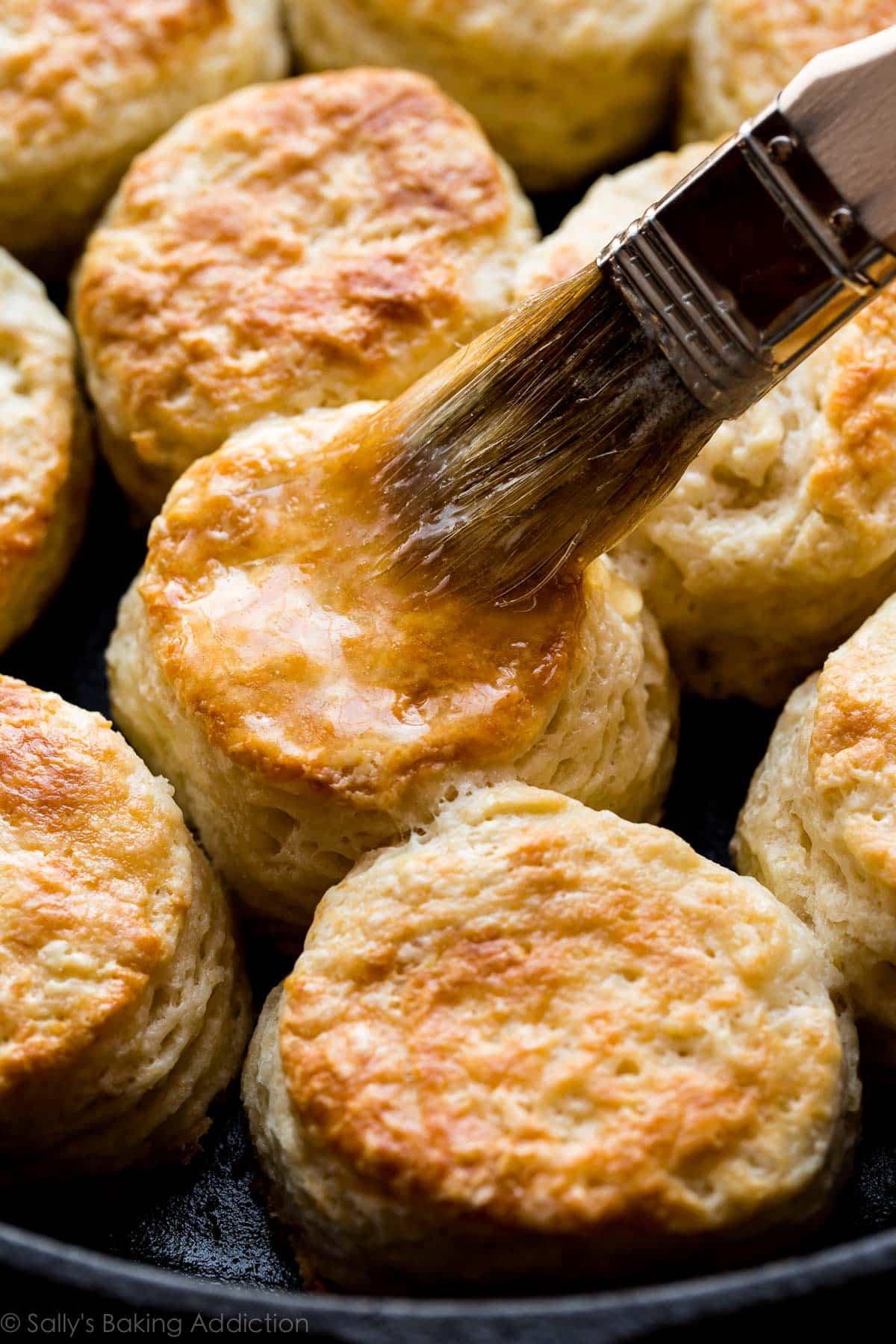
Biscuit Variations
I bake biscuits often, and use the same process and success tips when making all of my favorite variations including cheddar biscuits, everything bagel biscuits, and zucchini biscuits. I also make biscuit-topped vegetable pot pie and biscuit breakfast casserole. And you can absolutely turn these into dessert with my recipes for biscuit-topped berry cobbler and homemade strawberry shortcake!
I make these biscuits on almost a weekly basis, and what makes them a hit every single time, is the combination of very cold butter and buttermilk. Also, be sure to use the amount of baking powder in the recipe below, or try the baking powder and baking soda combination I explain in the recipe Note.
Bake the biscuits in a cast iron skillet, which helps the edges crisp up beautifully. Additionally, use a pastry brush to coat the tops of the biscuits with a little buttermilk before baking.
You can use a food processor to cut the cold butter into the dry ingredients, but if you do not own one, you can use a pastry cutter instead. A pastry cutter is an extremely helpful baking tool!
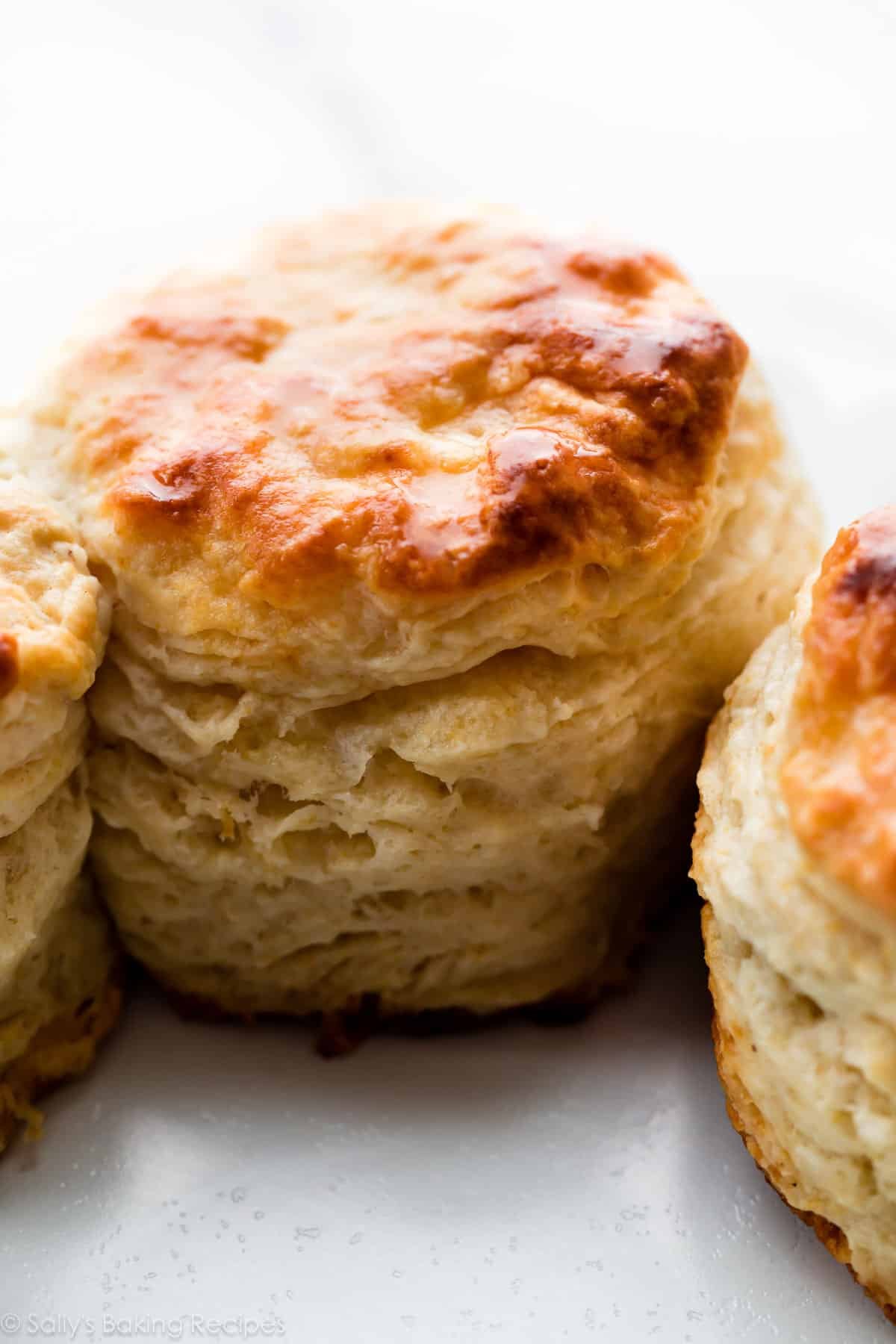
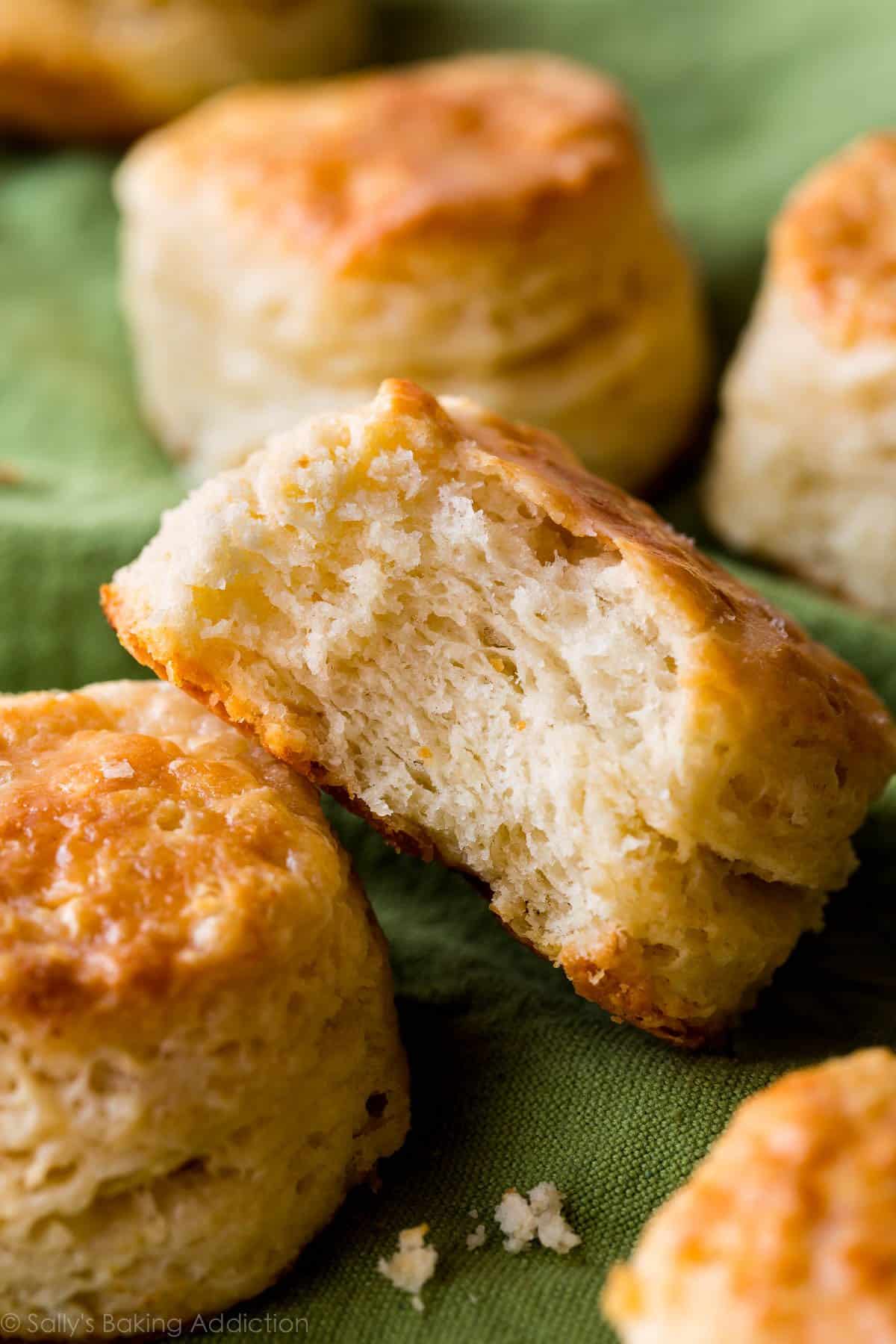
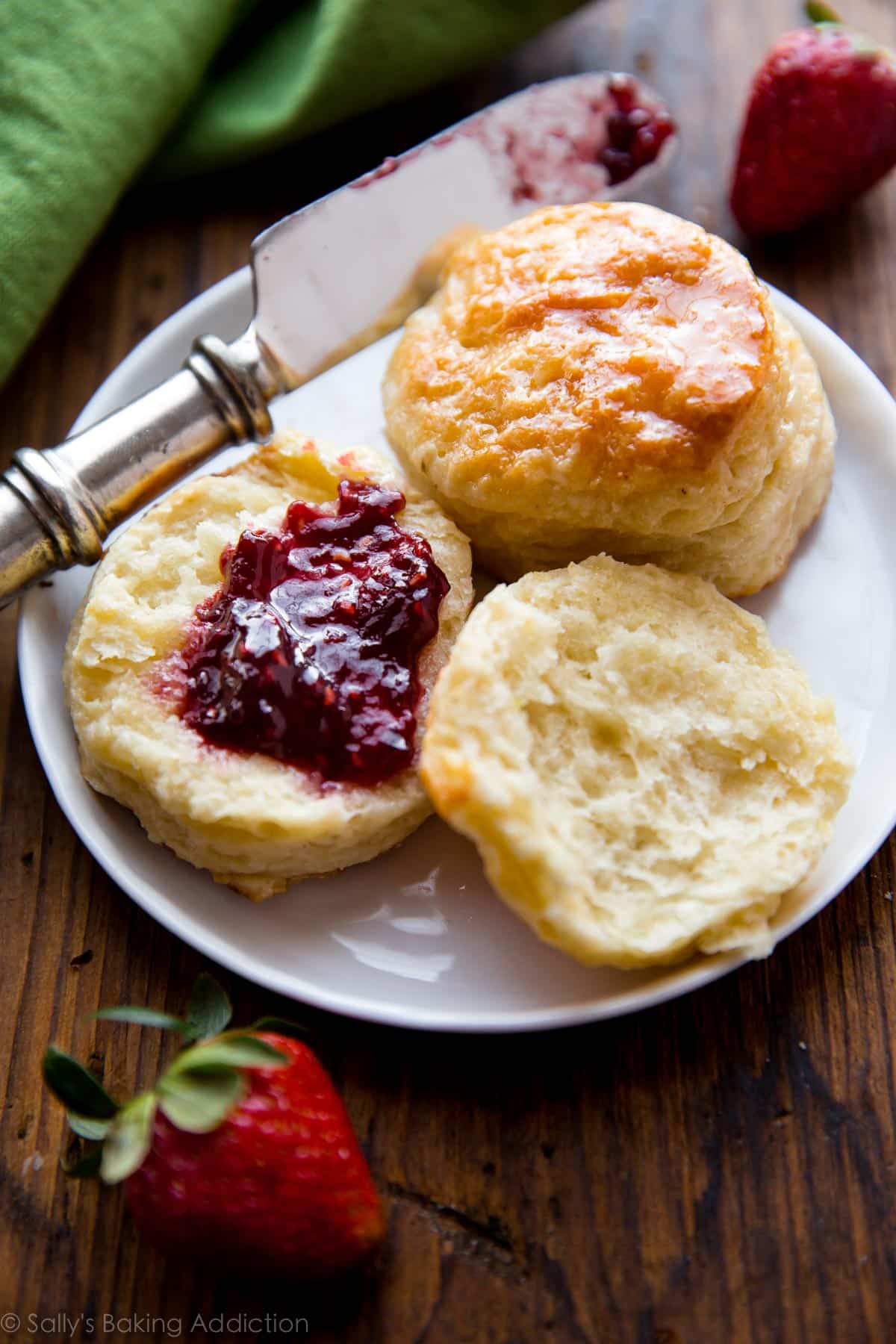
If you enjoy biscuits, try homemade ham & cheese scones and/or my easy no yeast cinnamon rolls.
Even More Biscuits
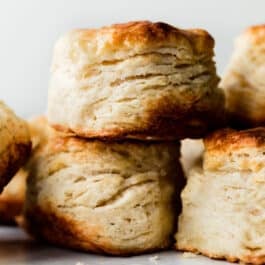
Homemade Buttermilk Biscuits (Popular Recipe!)
- Prep Time: 20 minutes
- Cook Time: 15 minutes
- Total Time: 35 minutes
- Yield: 8-10 biscuits
- Category: Bread
- Method: Baking
- Cuisine: American
Description
These homemade buttermilk biscuits are soft and buttery with hundreds of flaky layers! This biscuit recipe only requires 6 simple ingredients and they’re ready in about 35 minutes.
Ingredients
- 2 and 1/2 cups (313g) all-purpose flour (spooned & leveled), plus more as needed for hands and work surface
- 2 Tablespoons aluminum free baking powder (yes, Tablespoons)
- 1 teaspoon salt
- 1/2 cup (8 Tbsp; 113g) unsalted butter, cubed and very cold (see note)
- 1 cup + 2 Tablespoons (270ml) cold buttermilk, divided
- 2 teaspoons (14g) honey
- optional honey butter topping: 2 Tablespoons melted butter mixed with 1 Tablespoon honey
Instructions
- Preheat oven to 425°F (218°C).
- Make the biscuits: Place the flour, baking powder, and salt together in a large bowl or in a large food processor. Whisk or pulse until combined. Add the cubed butter and cut into the dry ingredients with a pastry cutter or by pulsing several times in the processor. Cut/pulse until coarse crumbs form. See photo above for a visual. If you used a food processor, pour the mixture into a large bowl.
- Make a well in the center of the mixture. Pour 1 cup (240ml) buttermilk and drizzle honey on top. Fold everything together with a large spoon or spatula until it begins to come together. Do not overwork the dough. The dough will be shaggy and crumbly with some wet spots. See photo above for a visual.
- Pour the dough and any dough crumbles onto a floured work surface and gently bring together with generously floured hands. The dough will become sticky as you bring it together. Have extra flour nearby and use it often to flour your hands and work surface in this step. Using floured hands, flatten into a 3/4 inch thick rectangle as best you can. Fold one side into the center, then the other side on top. Turn the dough horizontally. Gently flatten into a 3/4 inch thick rectangle again. Repeat the folding again. Turn the dough horizontally one more time. Gently flatten into a 3/4 inch thick rectangle. Repeat the folding one last time. Flatten into the final 3/4 inch thick rectangle.
- Cut into 2.5 or 3-inch circles with a biscuit cutter. (Tip: Do not twist the biscuit cutter when pressing down into the dough because this seals off the edges of the biscuit which prevents them from fully rising.) Re-roll scraps until all the dough is used. You should have about 8-10 biscuits. Arrange in a 10-inch cast iron skillet (see note) or close together on a parchment paper-lined baking sheet. Make sure the biscuits are touching.
- Brush the tops with remaining buttermilk. Bake for 18-20 minutes or until tops are golden brown.
- Remove from the oven, and then brush warm tops with optional honey butter, and serve warm.
- Cover leftovers tightly and store at room temperature or in the refrigerator for up to 5 days.
Notes
- Make Ahead & Freezing Instructions: Baked biscuits freeze well for up to 3 months. Thaw at room temperature or in the refrigerator, then warm up to your liking before serving. You can also freeze the biscuit dough. Prepare the dough in steps 2 through 4. Wrap up tightly in plastic wrap (plastic wrap is best for freshness) and freeze for up to 3 months. Thaw overnight in the refrigerator, then continue with step 5. Also, after step 4, you can wrap the dough in plastic wrap and refrigerate for up to 2 days before continuing with step 5.
- Special Tools (affiliate links): Pastry Cutter or Food Processor | 2.5- or 3-inch Biscuit Cutter | 10-inch Cast Iron Skillet (or Baking Sheet with Parchment Paper) | Pastry Brush
- Baking Powder: To avoid a chemical aftertaste, make sure your baking powder is labeled aluminum free. I usually use Clabber Girl brand and though the ingredients state aluminum, I’ve never noticed an aluminum aftertaste. Alternatively, you can reduce the baking powder down to 1 Tablespoon and add 1/2 teaspoon baking soda.
- Butter: Cut into 1/2-inch cubes. Keep butter as cold as possible until you need it. I recommend placing the cubed butter in the freezer for about 15 minutes before you begin.
- Buttermilk: You can substitute whole milk for buttermilk if desired. However if you’d like the tangy flavor, which I highly recommend, you can make your own DIY buttermilk substitute. Add 2 teaspoons of fresh lemon juice or white vinegar to a liquid measuring cup. Add enough milk to make 1 cup. (You need 1 cup in the recipe, plus 2 Tbsp for brushing–you can use regular milk to brush on top.) Whisk together, then let sit for 5 minutes before using in the recipe. Whole milk is best for the DIY sour milk substitute, though lower fat or nondairy milks work in a pinch. (In my testing, the biscuits don’t taste as rich or rise quite as tall using lower fat or nondairy milks.)
- Cast Iron Skillet: If your cast iron skillet isn’t well seasoned, I recommend greasing it with a little vegetable oil or melted butter. Brush a thin layer of either on the bottom and around the sides. No need to heat the cast iron skillet before using, though you certainly can. Place in the preheated oven for 15 minutes before arranging the shaped biscuits in it.
- Flavors: Try my flavorful biscuit variations: cheddar biscuits and everything bagel biscuits.
Nutrition
- Serving Size: 1 biscuit
- Calories: 212
- Sugar: 2.4 g
- Sodium: 283.5 mg
- Fat: 9.7 g
- Carbohydrates: 27.5 g
- Protein: 4.1 g
- Cholesterol: 25.4 mg
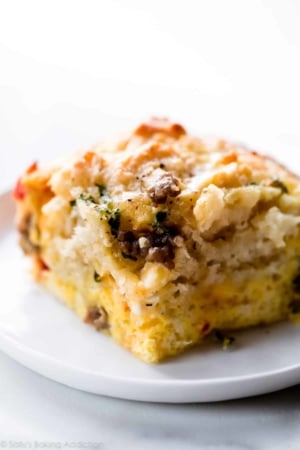
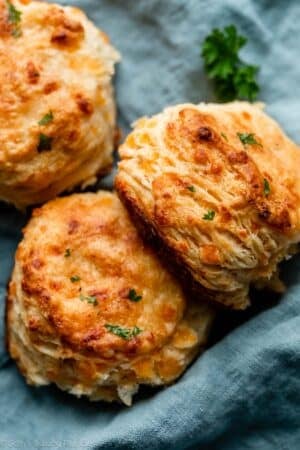
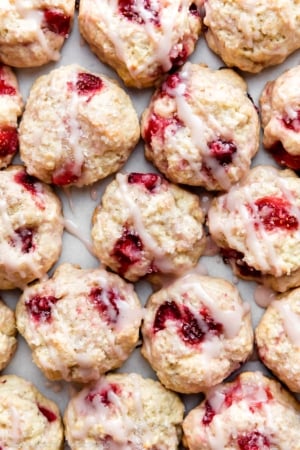
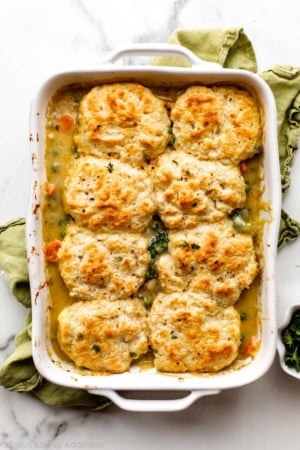





















Great recipe
Will a blender work as well as a food processor or for mixing in the butter?
Hi Sakeena, a blender will work, just be very careful not to overwork the butter.
These are the most perfect biscuits I have ever made. They were soft and fluffy. Rose perfectly. I used my homemade butter and the buttermilk I cultured myself. I took pictures for my mom. I’m above and beyond proud of these. Thank you Sally! Every Sally recipe turns out perfectly.
I’ve never baked before and each time
I’ve followed Sally’s recipes I’ve created amazing things I’ve never been able to before! My girlfriend loves lemon bars and I am no baker—first time lemon bar baker here following Sally and they came out perfect. Now I’ve made this biscuit recipe (I’ve never made biscuits in my life) and my girlfriend’s office LOVED them and think I’m some skilled baker. Thank you so much Sally, your steps are so helpful and the photos and extra information you include really helps people like me get into baking!
Made these confidently and had to throw them out. TOO MUCH BAKING SODA. DONT do that
Baking powder and baking soda are very different. The baking powder was required for this recipe.
Perfect! I have finally found a keeper recipe. I make this quite often and the biscuits always come out delicious.
Will bread flour work in a pinch or will that make it too chewy?
Hi TW, You could use the same amount of bread flour. The biscuits will be chewy.
These were SO good. Fluffy and buttery on the inside, browned and crisp on the outside. They are great on their own or used for breakfast biscuit sandwiches. Mmm. Thanks, Sally!
Legit the best biscuit recipe I have found
Great recipe! Thanks so much!
These turned out so good, but unfortunately they were flat for me and did not rise even though I followed all the instructions. Do you know what would have caused that to happen?
Hi Aya, We’re happy to help troubleshoot. It could be the butter, did it seem quite warm? Make sure not to over-mix the dough. Over-mixing can cause flat, hard biscuits rather than tall and fluffy. Also, be sure not to twist your biscuit cutter. Twisting it seals off the edges and prevents them from rising. This helps them to rise nice and tall! Is your baking powder expired? It may be worth getting a fresh one. Hope these tips help!
I found that the biscuits that were not touching the edge of the pan or another biscuit did not rise as well. Just an FYI!
I had some leftover buttermilk from a different recipe so I was looking for something that would be easy and freezable. This did the trick. The biscuits are delicious and work as a savory or sweet side.
Usually I love Sally’s recipes, but not this one. I reduced the salt and it was still far to salty. It was starting to burn after 14 minutes in the oven. 4 minutes shy of the required time. Normally I use a recipe that uses shortening as it’s fat, but this time I changed it u to the recipe with all the butter recommended. I suspect that’s why it burnt.
Great recipe with a few mods. 1 1/3C buttermilk, shaped and folded 4 times in total. Placed on parchment paper lined cookie sheet and chilled in freezer for 10 min. This really helps if ingredients were not cold enough and it prevents the dreaded, collapsed, biscuits.
I made the recipe exactly as printed, except, I used Gluten free flour. After 18 minutes baking the biscuits were brown but the interior looked underdone. I cooked them 3 minutes longer. The interior still looked underdone and was not flakey. The flavor was fine and we enjoyed them but I missed the flakey texture. Do you have experience with Gluten free flour and think that could have caused this problem?
Hi Corinna, we haven’t tested this recipe with any gluten free flours, so we’re unsure of the results. Perhaps another reader who has can chime in. Thank you for giving these a try!
I had the same problem using regular (non GF) flour. Baked for 20 min and the inside is underbaked and doughy. I added another 5 minutes, but as they were getting too brown, I took them out. I noticed that in the folding process creating layers, the last layer was pretty much divided into two, so I separated the two layers and baked each for an additional 10 minutes. Somewhat better, but still more doughy than I would like. What did I do wrong? Thanks!
Hi Kate, was your dough overworked perhaps? Overworking the dough can cause the butter to melt too much and create dense, doughy layers rather than light, flaky layers. If you find the dough/butter is getting too warm as you work with it, you can always stick the dough back in the refrigerator to cool things down before starting up again. Hope this helps for next time!
I have made these with success in the past. I just bought a bag of self rising flour. Can I substitute the self rising flour instead of the AP? Would I need to reduce or remove the baking powder? I was thinking of cutting the baking powder and salt in half but unsure.
Hi Melissa, we don’t recommend using self raising flour here. It’s not always a 1:1 swap with all-purpose, so it’s better to use the combination of all-purpose flour and baking powder as written.
Hi Sally! I love these biscuits and my family does too! They would love it if I made them much more often! I was wondering if you have a recipe for a biscuit mix that could be kept in the fridge and I could just grab and add a few more ingredients and get these biscuits out even faster. I also have a biscotti type cookie recipe that calls for a biscuit mix as well as flour, and I could make those more easily too. Thank you and may God bless you!
Hi Doree, we’re so glad these are a favorite for you! We do not have a biscuit mix, but you could prepare and store the dry ingredients ahead of time.
These turned out great, following your recipe exactly with these exceptions: 1% milk with lemon juice to sub for buttermilk, 375* in my convection oven. I would love them to be a little less brown on the outside. Do you suggest decreasing oven temp or covering them with foil (at beginning or end of baking time?).
Hi Bonnie, With a convection oven, along with decreasing the temperature which you’ve already done, you may also need to decrease the baking time. If you see them getting too brown next time, you can tent them with foil!
Great biscuits! I think the technique must be what makes them so special ( with layers)
Great biscuits!! Which rack in oven should you cook them on?
Hi Diane, so glad you enjoyed these! If the heating element is on the bottom of your oven, you can move to a higher rack than you would normally to avoid burning the bottoms.
Too much baking soda, they were inedible, so sad!
Hi Kerry-Lou, If the baking powder taste is coming through too strong, make sure that you are using aluminum free baking powder.
I use Bob’s Red Mill baking powder and 2 1/2 teaspoons was perfect.
Please adjust the baking soda. My young still tastes it. I had to trash them. Otherwise looked good.
Hi,
I know it’s possible to refrigerate the rolled out dough before cutting and baking, but is it possible to cut the biscuits out and put on sheet pan wrapped in refrigerator for a few hours up to 2 days or no?
Thanks 🙂
Hi Crystal, we recommend sticking with refigerating the rolled out dough rather than cutting the biscuits and then refrigerating.
This recipe is amazing. I make this one or two times a week. I use a scale and measure everything out In grams that way and also bake at 400 degrees for 10 minutes on parchment paper lined cookie sheets. We make our own elderberry and wild blackberry jelly so this is the perfect pairing. My family is addicted! Thank you for such a wonderful recipe.
This is my go-to biscuit recipe! Love making these in the morning for biscuits and gravy or to go with preserves. How long is the dough good for before baking? Can I prep these the night before to bake when we wake up?
Hi Kay, see recipe Notes for our recommended make-ahead instructions. So glad you love them!
I made the recipe and the biscuits rose beautifully and appeared to have layers. Nicely browned tops and bottoms. I used a food processor, baking at a slightly lower temp in a convection oven with cast iron pan for same amount of time. Biscuits came out risen high, but were quite “heavy”. Would love feedback. Love the web site. Thank you.
Hi Rick, I’m happy to help troubleshoot. It sounds like they were mostly fine, but a little too heavy for your liking and not as light and flaky as you’d like?
Okay so I was as skeptical as anyone when it mentioned 2 tablespoons of baking powder! I followed the recipe exactly and baked in a 12 inch cast iron pan (all I had) I was a bit worried it wouldn’t be in the sweet side so I sprinkle sugar on the tops after the buttermilk wash. Due to a flour shortage a while ago I had to use a generic AP flour, that to me, was more of a bread flour/more gluten. When I mixed the wet and dry it was so very crumbly and hardly holding together so it took a harder hand to make it come together. I also had to use a rolling pin to keep it together. So I lost any expectation of a good biscuit. In spite of this, they turned out better than I had hoped. I would definitely say it’s more on the savoury side and tastes like a premade mix. It still rose lovely and tasted good. I honestly had no hope of it turning out but it rose beyond my expectations and would definitely recommend.
First time ever fail : I put the buttermilk on top, which I rarely do, then looked at my oven temp and it was below 300 degrees. The biscuits didn’t rise to their normal height. Be warned, have everything ready to go !
Hello, just want to ask is scones and Homemade Buttermilk Biscuits are the same? Thank you!
Hi Zette, great question! See the section in the blog post titled “What are Biscuits?” for a quick background on what biscuits are in different parts of the world. Hope this helps!
These biscuits came out perfect! They were fairly simple to make, and came out golden brown on the outside, and fluffy and soft on the inside (with lots of layers too). They also reheated well the next day. Thanks for a great recipe!
Can we grate the butter instead, like we do in your master scone recipe?
Hi Colette, yes, many readers have reported success using that method here. Hope you enjoy the biscuits!